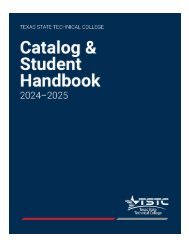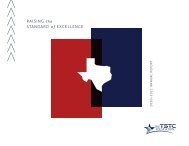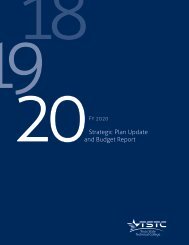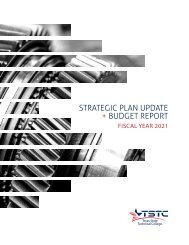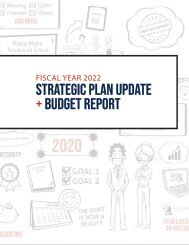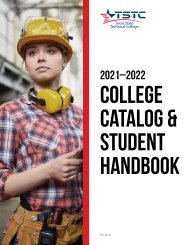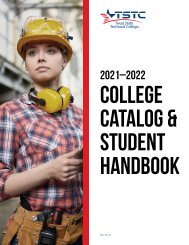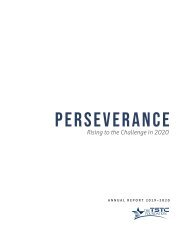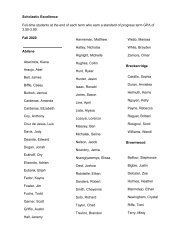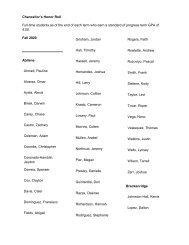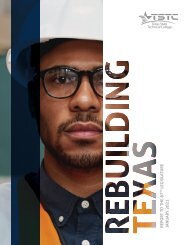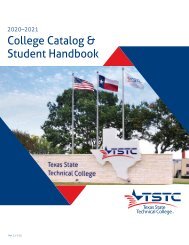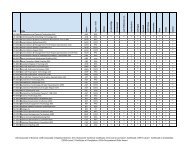TSTC Visual Standard Guide 2020
TSTC Visual Standards Guide 2020
TSTC Visual Standards Guide 2020
Create successful ePaper yourself
Turn your PDF publications into a flip-book with our unique Google optimized e-Paper software.
04 Career Services<br />
06 Résumé <strong>Guide</strong>lines<br />
13 Microsoft Editing Tips<br />
14 How’d the Other Guys Say It?<br />
15 Power Verbs<br />
16 Résumé Sample<br />
20 Cover Letter Sample<br />
21 Reference List Sample<br />
22 Veteran Résumé<br />
23 Transferable Skills<br />
26 10 Rules for Business Etiquette<br />
hire<strong>TSTC</strong>.com<br />
job. Consider what you would not do or not give up<br />
in order to work somewhere. Are you a very strong<br />
family person? Then you probably wouldn’t want a<br />
job that takes you away from home for a week.<br />
After you complete your lists, go through them<br />
and ask yourself:<br />
• Are there things on this list that I feel a sense of<br />
pride or accomplishment about?<br />
• Will any of these qualities and traits be something<br />
a prospective employer is looking for?<br />
Start Focusing<br />
Now that you have gone through and created your<br />
lists, go back and think about which items pertain<br />
to your posting. Cross out anything that doesn’t<br />
relate. Remember, the purpose of a résumé is to<br />
get your foot in the door. It is not meant to be a full<br />
recollection of your life history. Employers are looking<br />
for a one- to two-page résumé — no more. If you have<br />
a long history of jobs, you may want only to list jobs<br />
for the last five years, no more. You can talk about<br />
older jobs at the interview.<br />
From your revised list, start creating clear and concise<br />
statements that explain what you have done. You<br />
should research and review examples of résumés on<br />
the internet in order to get an idea of how you should<br />
write these statements. Remember, be clear, concise<br />
and to the point — not wordy (there is a difference).<br />
Make sure that every word in every statement means<br />
something and contributed to the quality of the<br />
statement. Include action verbs at the beginning of<br />
each statement, words such as “performed,” “reviewed”<br />
and “prepared.”<br />
Each sentence should include keywords from the job<br />
posting, words that the employer listed as job skills<br />
that he/she wants. These are words that they will be<br />
looking for. Another tool for culling through too many<br />
applications is to search for those keywords. If you<br />
don’t have them, your résumé could end up in the<br />
trash. Again, remember never to include a keyword or<br />
phrase of a skill that you do not have; eventually the<br />
employer will find out.<br />
hire<strong>TSTC</strong>.com<br />
27 Networking<br />
28 Interview Attire — Female<br />
29 Interview Attire — Male<br />
30 10 Rules for Interviewing<br />
32 Interview Questions 101<br />
37 Advice From the Experts<br />
39 Questions Employers Ask<br />
41 Questions to Ask Employers<br />
42 Balancing Multiple Job Offers<br />
43 <strong>TSTC</strong> Alumni Network<br />
44 What Is Total Compensation?<br />
What is a résumé for?<br />
04 ..............................ONEOK<br />
05 ..............Morrow Energy<br />
07 ......................... Crown Lift<br />
24 ....................Mustang/Cat.<br />
25 ........................KBA/Tenaris<br />
31 .......................................Acme<br />
34 .................................. Chevron<br />
35 ....................................... CEC/TI<br />
38 ...........................U.S. Air Force<br />
40 .......................................... Toyota<br />
45 ................... General Sponsors<br />
Career Services would like to help you<br />
create a great résumé, reference page<br />
and cover letter. You will need to start by<br />
working on listing all of your information<br />
and qualifications so you will be ready<br />
to begin your résumé.<br />
A résumé is the most important tool you have to<br />
sell yourself to future employers. It outlines your<br />
skills and experiences so an employer can see, at<br />
a glance, what you can bring to the organization. It<br />
has one purpose: to get your foot in the door. It has<br />
to be created to make a lasting impression on that<br />
particular employer.<br />
Employers tell us they receive 50–100 applicants<br />
for every position. They have to find a way to cull<br />
through this mass of résumés. So appearance<br />
and proper grammar, spelling and format are very<br />
important. You could be the best person for the<br />
job, but if you don’t survive their culling strategies,<br />
the employer will never know it. So the first thing<br />
a résumé has to do is bypass the “trash pile” of<br />
résumés. Remember, appearance is very important.<br />
Then your next hurdle will be to prepare a résumé<br />
that someone wants to read, that has the<br />
qualifications they are asking for. So the more<br />
carefully you prepare your résumé now, the more<br />
likely someone is to read it later.<br />
Another very important point to make is to be<br />
completely honest on your résumé. You must tell<br />
the truth. It is very easy for employers to verify<br />
the facts that you include on your résumé. Most<br />
employers will dismiss employees, even years<br />
later, if they find they have been dishonest on their<br />
résumé and applications. Also, remember that your<br />
résumé and everything with it becomes a part of<br />
your permanent file.<br />
All of these lists should be reviewed again<br />
before you go on a job interview. The employer<br />
will ask questions about your skills, and if<br />
you have reviewed these lists, then you will<br />
remember what you should talk about.<br />
tstc.edu<br />
How do you create a résumé that someone<br />
wants to read and that will capture a<br />
prospective employer’s attention?<br />
First, it has to be an effective résumé focusing on a<br />
specific job and, when possible, meet the employer’s<br />
stated requirements that they had in the job posting.<br />
This means if you have the skills listed in the<br />
job posting, then be sure and include them in the<br />
Summary of Qualifications because this is what the<br />
employers will be looking for.<br />
Second, your résumé needs to be more than a list<br />
of education and work experience. You must also<br />
recognize what skills, interest and life experiences<br />
are needed to succeed in the occupation — and<br />
highlight these on the résumé. This is the reason<br />
you will be taking the time to work on this list of<br />
your qualifications, skills and abilities, as well as your<br />
education and work experience. It may be a good<br />
idea to start researching the positions available for<br />
your degree so you can see what responsibilities are<br />
required for someone in your field. As you are looking<br />
through job postings for your career, when you look at<br />
each requirement, write that requirement down and<br />
determine how you can meet that requirement. Don’t<br />
forget your interpersonal skills: being responsible,<br />
dependable, having initiative, etc. These all are<br />
qualities that employers are looking for also.<br />
When you are creating your résumé, you should try<br />
to put yourself in the employer’s position. Remember,<br />
they may be asking themselves, “Why should I speak<br />
with this person? What can they bring to the company?<br />
How is he/she different from all the other applicants?”<br />
Then you are going to have to create the résumé that<br />
stands out above 50 or more résumés.<br />
How do you start writing?<br />
The hardest part about writing a résumé is starting<br />
to write the résumé. First, you need to think about<br />
what image you want to project and what your past<br />
experiences, training and work history can bring to<br />
that image. If you worked in a fast-food restaurant,<br />
don’t sell yourself short, feeling you lacked qualities. If<br />
you were a team leader, dependable, responsible and<br />
had great customer service, then think what it took to<br />
be each of these. Try to take a positive attitude about<br />
what you have to offer.<br />
You will also need to create a “Summary of<br />
Make sure to keep your career portfolio updated<br />
with all of the information you have listed.<br />
#itsyourmove<br />
Qualifications” section to put at the top of your<br />
résumé. But you need to make sure it is precise and<br />
not a bunch of gibberish. Basically, it is a beginning<br />
summary of who you are and what you do. Be sure and<br />
review the skills the job posting has recommended,<br />
and if you have them, then include them in this section.<br />
Take Inventory<br />
Before you begin your résumé, take inventory of what<br />
you can offer the company. Take out several pieces<br />
of paper. Title each with the following headings and<br />
then brainstorm and make notes about anything in<br />
each title that would benefit you in your career.<br />
Work Experience: For every job you have had, make<br />
a list of everything that you have accomplished or<br />
completed that made you a good employee. Just<br />
as important, make a list of tasks that you had to<br />
complete that you didn’t like so you will be able to<br />
identify them. You will list your work experience in<br />
reverse chronological order.<br />
Education: For your education list, list the schools<br />
you have attended, educational qualifications, any<br />
relevant education or training you’ve received that<br />
relates to the job — don’t forget your internships<br />
and clinicals. If you have or will complete a college<br />
degree or certificate, it is no longer necessary to add<br />
your high school information. If you have more than<br />
one degree, you will list your education in reverse<br />
chronological order.<br />
Skills and Abilities: As you go through each skill and<br />
ability, write down what it took to be successful at<br />
the skill you have listed.<br />
Activities: List your hobbies; clubs or groups you belong<br />
to; sports, school activities; organized groups;<br />
community involvement; and volunteer activities.<br />
Be sure and list any leadership positions you have<br />
held and the responsibilities that you had.<br />
Honors and Awards: List scholarships, special<br />
recognitions and academic achievements.<br />
Values: Identifying your values is very important when<br />
you are deciding which position to take. Your values<br />
determine what really matters to you. You also need<br />
to identify what values you need to avoid on the<br />
Finishing Up Your Résumé<br />
After you go through and complete the inventory of<br />
all your education, work history and skills that should<br />
be included in your résumé, the only thing left to do<br />
is to review the Résumé and Cover Letter examples,<br />
then complete your résumé.<br />
Résumés<br />
There are three basic types of résumés:<br />
Reverse Chronological<br />
• Present information in a timeline approach. The most<br />
recent work or educational experience is listed first,<br />
followed by the next most recent.<br />
• Best used if you have work experience that supports<br />
your desired position. It highlights the positions<br />
you have held and the companies for which you<br />
have worked.<br />
Functional<br />
• Group work experience and skills by skill area or job<br />
function. Use functional résumés to point out your<br />
skills over your specific employment history.<br />
• You can show the work experience and skills that are<br />
most important to your career objective. It can minimize<br />
employment gaps.<br />
• May work best for first-time job seekers, those<br />
re-entering the workforce after a long break from<br />
employment, or those changing careers.<br />
Combination (what is normally used)<br />
• Merge the chronological and functional styles. It presents<br />
the knowledge, skills and abilities gained from work in<br />
a reverse chronological order.<br />
• Highlights your skills and experience.<br />
• Best used if you have a varied employment history and<br />
are changing careers.<br />
Reference Page<br />
The new recommendations are that you don’t include<br />
your references on the résumé. Some employers are<br />
not interested in the references, but some are. We<br />
recommend that you complete a separate reference<br />
page. This will allow you to ask the employers if they<br />
are interested in reviewing it; if they are, you will have<br />
it available for them to review.<br />
You should copy the header that you have on your<br />
résumé to the reference page document. This will<br />
allow the reference page to look like a continuation<br />
of the résumé.<br />
7<br />
9<br />
DESIGN SAMPLES<br />
CONTENTS<br />
<strong>TSTC</strong> BUS STOP WRAP AUT - WACO (32476) _919<br />
CAREER SERVICES<br />
HOW TO WRITE A RÉSUMÉ<br />
page 6<br />
INTERVIEW QUESTIONS 101<br />
page 30<br />
10 RULES FOR INTERVIEWING<br />
page 28<br />
BUS<br />
STOP<br />
ADVICE FROM THE EXPERTS<br />
page 35<br />
Advertiser Index:<br />
Live with certainty.<br />
Others are<br />
depending<br />
on you.<br />
make<br />
YOUR<br />
move<br />
BUS<br />
STOP<br />
HOW TO LAND THAT JOB<br />
BUS<br />
STOP<br />
WRITING YOUR<br />
RÉSUMÉ<br />
LEFT SIDE<br />
<strong>TSTC</strong> BUS STOP WRAP AUT - WACO (32476) _919<br />
LIST<br />
BUS<br />
STOP<br />
BUS<br />
STOP<br />
FRONT<br />
RIGHT SIDE<br />
<strong>TSTC</strong> BUS STOP WRAP AER - WACO (32476) _919<br />
BUS<br />
STOP<br />
BACK<br />
LEFT SIDE<br />
TECHNICALLY BETTER<br />
FRONT<br />
LEFT SIDE<br />
UPDATE<br />
RIGHT SIDE<br />
FRONT<br />
BACK<br />
RIGHT SIDE<br />
hiretstc.com<br />
BACK<br />
<strong>TSTC</strong> BUS STOP WRAP AUT - WACO (32476) _919<br />
<strong>TSTC</strong> BUS STOP WRAP AER - WACO (32476) _919<br />
<strong>TSTC</strong> BUS STOP WRAP CNS - WACO (32476) _919<br />
<strong>TSTC</strong> BUS STOP WRAP AUT - W<br />
BUS<br />
STOP<br />
BUS<br />
STOP<br />
BUS<br />
STOP<br />
BUS<br />
STOP<br />
BUS<br />
STOP<br />
BUS<br />
STOP<br />
BUS<br />
STOP<br />
LEFT SIDE<br />
LEFT SIDE<br />
RIGHT SIDE<br />
LEFT SIDE<br />
BACK<br />
RIGHT SIDE<br />
BACK<br />
RIGHT SIDE<br />
BACK<br />
FRONT<br />
FRONT<br />
FRONT<br />
LEFT SIDE<br />
FRONT<br />
<strong>TSTC</strong> BUS STOP WRAP AER - WACO (32476) _919<br />
<strong>TSTC</strong> BUS STOP WRAP CNS - WACO (32476) _919<br />
112<br />
<strong>TSTC</strong> | BRAND IDENTITY<br />
<strong>TSTC</strong> BUS STOP WRAP AER - WA<br />
BUS<br />
BUS<br />
BUS<br />
BUS



